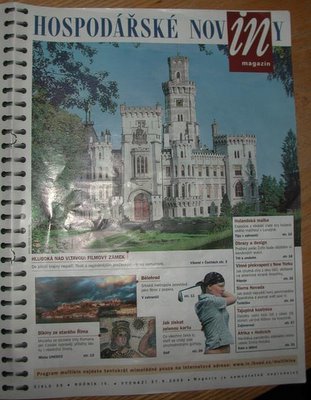Hospodářské noviny and the Case of the Roman Bikini

While nosing around Jesse’s kitchen this weekend, I noticed a copy of the Hospodářské noviny (Economic News) lurking atop the cupboard. I had always imagined Hospodářské noviny to look something like the Wall Street Journal, but instead it is a small four-color magazine-style publication. (Well, this part was.) This issue, to my astonishment, featured an elaborate castle on the cover, with the caption “Hluboká nad Vltavou: Filmový zámek.” I picked up the magazine in order to take a better look at the thing, and immediately found my attention diverted instead to a smaller heading entitled “Bikiny ze starého Říma.” Bikinis in ancient Rome?! What could this possibly have to do with economic news? The castle at Hluboká nad Vltavou could at least be considered to be attracting the film industry. But the mosaics in Sicily’s Villa Romana del Casale, while part of a UNESCO site, were described as telling a story of love in everyday life.
I had a good notion of which mosaic was involved, since I have seen a good many reproductions of Roman mosaics, but I could not imagine what it was doing in Hospodářské noviny, especially in the form of an ancient love story. I promptly turned to page 15 to find out.

First off, the main photo on the page is not of the “bikini”-clad Roman woman, but of a female clad primarily in jewelry. This seemed to me a remarkably Czech manner of illustrating an article about a UNESCO site, but still not what I would have expected from Hospodářské noviny—more like what one would find in the tabloid Blesk, should it ever happen to feature a Roman mosaic.
The first pull-quote (in red ink) indicated that Roman bikinis pose many questions, or at least are associated with questions (“Římské bikiny a plno otázek”). This seemed just bizarre to me—not that there might be questions about Romans or their clothing, but again, that Hospodářské noviny would be asking them.
I began to examine the text. The entire lead paragraph focused on how the modern bikini took the world by storm after World War II! The second paragraph then pointed out that the bikini has been around for a lot longer than that, because the most celebrated examples show “girls” (dívky) in Roman mosaics cavorting in two-piece outfits, and (in subsequent paragraphs) that beautiful women often appeared in Roman mosaics from the time of the caesars (presumably to divert people from their economic and political woes). The author of the piece ponders the Roman ideal of female beauty and refers to pictures of a “sportive type” of slender, muscular women with long hair and small round breasts (or you could translate the latter bit as “minute, globular boobs,” which I was initially tempted to do but which is probably less positive than what the author intended by “drobnými kulatými ňadry”).
I’m not sure, but I am inclined to think the author was inserting his own concept of ideal female beauty there. It’s true that the Roman ideal for women does not seem to have called for large breasts, but I have yet to see an image of an ancient Roman woman that struck me as muscular. More often, I would say that they are shown (when unclothed) with implausibly enlarged hips and buttocks that suggest this part of their anatomy had been artificially inflated (that is, not enlarged in the manner of persons who are by nature extensively endowed in this region, but maybe with the help of a bicycle pump). Then again, I don’t know how representative a sample the wall paintings at Pompeii and Herculaneum actually were. Perhaps they depict a subgroup or a subcultural interest, and the Sicilian bikini-women are more like the average imperial dancing girl.
There is a small amount of information in the article about the archaeology of the site, but mainly in regard to how the entire villa was buried in muck.
After I noticed that another front-page item in Hospodářské noviny related to golfing but was illustrated with an apparently bottomless female golfer (a larger photo of her on page 28 shows that she merely wears extremely low-cut pants), I concluded that Hospodářské noviny is indeed not the periodical I had been led to believe it was. Jesse confirmed this by assuring me that his impression had been that it seemed to feature the kind of articles we might have expected to find in Blesk; except, I suppose, for a more literate audience that doesn’t admit to watching reality TV. It’s not that I object to reading fluff about Romans in bikinis, I just have the puritanical American feeling that that level of journalism belongs in the travel sections of the more frivolous newspapers, or maybe in the pages of Cosmopolitan. (Note: I have since discovered that the section I found in the kitchen was from the paper’s “magazine” section.)

Unesco’s web site provides a more factual discussion of the mosaics, although not without reference to “bikini girls.” There are numerous photos of mosaics and other parts of the villa. Hospodářské noviny can be examined online as well as in Jesse's kitchen.

2 Comments:
I love the mosaic photos you posted. Thanks! I love to travel and I especially enjoy Roam and Greek mosaics--they have inspirted me to take up the art form!
Peace,
Clearbrook
Be sure to check out the many mosaic photos at the UNESCO website, they cover what must be everything in the villa. And I'm sure you must be familiar with the gorgeous Byzantine church mosaics in Ravenna (hope to see them myself someday in more than just reproductions).
Post a Comment
<< Home